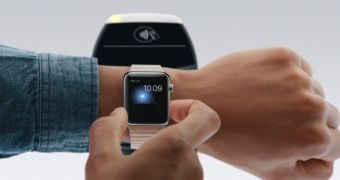Since Apple announced their Apple Pay contactless payment service on October 20, 2014, users have been using their iPhones to pay while shopping without having to reveal any personal information to the merchant.
After Apple Watch's release on April 24, 2015, the Apple Pay service can now be used without having to get your iPhone out of the pocket.
Moreover, if your iPhone does not come with the NFC (near-field communication) capabilities needed for contactless payment (i.e. all iPhones up to the iPhone 6 and 6 Plus), the Apple Watch enables you to use the Apple Pay service by setting it up on the Watch.
To be more exact, the Apple Watch allows you to use the Apple Pay service if you pair it with an iPhone 5, iPhone 5c, or iPhone 5s, running iOS 8.2 or later in the US and iOS 8.3 or later in the UK.
As a bonus to using Apple Pay on Apple Watch instead of your credit cards to make payments while utilizing your Apple Watch to pay in stores, no one will be able to tie your transactions back to you, thus making it easier to prevent store employees from knowing your name or your card number.
At the moment, Apple says that you can use the Apple Pay service in more than one million different stores and that the service works with credit and debit cards from banks in the US and UK.
If you want to know which banks offer cards compatible with the Apple Pay service, Apple provides a comprehensive list of all Apple Pay participating banks on their support website.
Furthermore, if you need to know if you can use Apple Pay in a store, you can do it by checking if the shop comes with an Apple Pay mark in the Maps app or while in the store by checking for the contactless symbol or the Apple Pay mark at the checkout counter.
Now, let's get to how you can configure your Apple Watch to work with Apple Pay. The steps for the Apple Pay Watch setup process are described in detail below, and once you go through the entire procedure, you will be able to pay for anything you buy at any Apple Pay participating store using your Apple Watch.
Step 1 - Add your credit card(s)
To use the Apple Pay service with the Apple Watch, you first have to set up Apple Pay on your iPhone using the procedure described by Apple on their support website.
Once you have Apple Pay working on your iPhone, you have to add the payment cards from the iPhone to the Apple Watch.
For this you have to first unlock the Apple Watch, open the Watch app on the iPhone and go to the My Watch tab. Here, scroll to the "Wallet & Apple Pay" option and tap it.
Now tap on the "Add" button next to the card you want to transfer to the Apple Watch, enter the security code for the card, tap "Next" and wait for the bank to verify the card, and afterwards tap "Next" and wait to be notified on the Watch that the card is ready to be used with Apple Pay.
At this step, you can also add a new card, by following the procedure described above but tapping on the "Add Credit or Debit Card" instead of adding a card already available on the iPhone.
Step 2 - Start shopping
After you've added all your debit and credit cards, you can now use your Apple Watch to make simple payments in any store that accepts contactless payments.
To pay with Apple Pay using the Apple Watch, you have to double-click the side button to see the default credit or debit card (you can switch between cards by swiping horizontally) and holding the Watch next to the contactless reader, just a few centimeters away.
After you hear a tone and feel a pulse on the skin, the payment has been accepted, and you are done.
You now know how to use Apple Pay without taking out your iPhone each time you have to make a payment and, more importantly, how to configure and use the Apple Watch to pay for merchandise while shopping.
Leave a comment below if you need further instructions on how to use Apple Pay on the Apple Watch, you have any tips or tricks about Apple Pay that you want to share with the rest of the readers, or you have any questions regarding the procedure described above.

 14 DAY TRIAL //
14 DAY TRIAL //